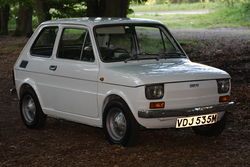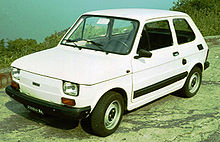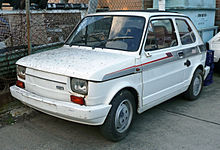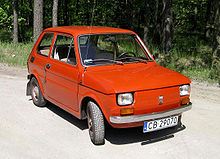- Fiat 126
-
Fiat 126
Polski Fiat 126p
Manufacturer Fiat (1972-1980)[1]
FSM (Polski Fiat 126p, 1973-1992)
Fiat Auto Poland (1992-2000)Also called Zastava 126 Production 1972–2000 Predecessor Fiat 500 Successor Fiat Cinquecento Class City car Body style 2-door fastback Layout RR layout Engine 594 cc Straight-2
652 cc Straight-2
704 cc Straight-2Wheelbase 1,840 mm (72.4 in)[2] Length 3,054 mm (120.2 in)[2] Width 1,378 mm (54.3 in)[2] Height 1,302 mm (51.3 in)[2] Curb weight 580–619 kilograms (1,300–1,360 lb) Related Fiat 133
SEAT 133The Fiat 126 is a city car introduced in October 1972 at the Turin Auto Show[1] as a replacement for the Fiat 500. Most were produced in Bielsko-Biała, Poland as the Polski Fiat 126p until 2000. It was replaced by the front-engined Fiat Cinquecento in 1993.
Contents
History
The 126 used much of the same mechanical underpinnings and layout as its Fiat 500 rear-engined predecessor with which it shared its wheelbase, but featured an all new bodyshell closely resembling a scaled-down Fiat 127.
Engine capacity was increased from 594 cc to 652 cc at the end of 1977 when the cylinder bore was increased from 73.5 to 77 mm.[3] Claimed power output was unchanged at 23 PS (17 kW), but torque was increased from 39 N·m (29 lb·ft) to 43 newton metres (32 lb·ft).[3]
A subsequent increase took the engine size to 704 cc in new "restyling" model Fiat 126 Bis (1987–1991), with 26 PS (19 kW) of motive power.
In Italy, the car was produced in the plants of Cassino and Termini Imerese until 1979. By this time 1,352,912 of the cars had been produced in Italy.
The car continued however to be manufactured by FSM in Poland, where it was produced from 1973 to 2000 as the Polski Fiat 126p. Even after the introduction of the 126 Bis (a 126p with water-cooled engine of indigenous Polish construction), the original model continued to be produced for the Polish market. The car was also produced under licence by Zastava in Yugoslavia. In 1984, the 126 received a facelift, giving it plastic bumpers (for all versions) and a new dashboard. This model named Fiat 126p FL. In 1994, the 126p received another facelift, and some parts from the Fiat Cinquecento, this version was named 126 EL. The 126 ELX introduced a catalytic converter.
Despite clever marketing, the 126 never achieved the frenzied popularity of the 500. The total number of 126 produced is : 1,352,912 in Italy, 3,318,674 in Poland, 2,069 in Austria, and an unknown number in Yugoslavia.
Polski Fiat 126p
The car was produced in Poland under the brand Polski Fiat 126p (literally in English: Polish Fiat 126p) between 1973 and 2000. At first it was almost identical with the basic model: differences included a higher chassis, a modified grille on the back, and the front blinkers that were white in Italy but orange for other markets. To distinguish it from the original Italian car, the letter "p" was added to its name. It was produced by Fabryka Samochodów Małolitrażowych (FSM) in Bielsko-Biała and Tychy under Italian Fiat licence. Due to a relatively low price it was very popular in Poland and was arguably the most popular car there in the 1980s. Its very small size gave it the nickname Maluch ("the small one","small child", pronounced [ˈmalux]). The nickname became so popular that in 1997 it was accepted by the producer as the official name of the car.
It was exported to many Eastern Bloc countries and for several years it was one of the most popular cars in Poland and in Hungary as well. It also found market success in Australia between 1989 and 1992, under the name FSM Niki. During that period it was Australia's cheapest car.[4]
History of PF 126p
- 1972 – the FSM car factory was built in Bielsko-Biała.
- 6 June 1973 – the first Polski Fiat 126p constructed from Italian parts. The official price was 69,000 Polish złotys with PKO Bank Polski accepting pre-payments on savings books starting 5 February 1973.[5]
- 22 July 1973 – the official opening of the factory's production line (by the end of that year over 1500 Fiats were manufactured).
- September 1975 – production started in a factory in Tychy.
- 1977 – engine capacity increased from 594 cc to 652 cc. Engine power increased to about 24 horsepower (18 kW).
- 1978 – production of types with engine capacity 594 cc ended.
- 1979 – production of Polski Fiat 126p continued only in Bielsko-Biała.
- 1981 – 1,000,000th Polski Fiat 126p produced.
- December 1984 – technical changes in the construction and body. Type FL introduced.
- 1987 – beginning of the production of the water-cooled Polski Fiat 126p Bis version (704 cc capacity).
- May 1993 – 3,000,000th Polish Fiat 126p produced.
- September 1994 – body improvement, creating type "el" with parts similar to those used in Fiat Cinquecento.
- January 1997 – introduction of a catalytic converter.
- 22 September 2000 – production ended after a production run of 3,318,674 units. All Fiats of the last limited Happy End series were yellow or red (500 cars in red and 500 cars in yellow).
The global production of this amiable car was 4,673,655 units: 1,352,912 in Italy, 2,069 in Austria by Fiat-Steyr and 3,318,674 in Poland.
Political connotations
The PF 126p has special meaning for Poles and its story had a connection with Polish politics during the communist period (Polish People's Republic, up to 1989). In a communist system, a private car was considered a luxury good, due to limited availability and low salaries. In 1971 there were only 556,000 passenger cars in Poland.[6] In a socialist planned economy, decisions on whether a state-owned factory could produce a car were taken on political and not just economic grounds. The authorities themselves initially did not find the idea of private cars attractive. The first relatively cheap Polish car was the Syrena, but its production was limited. Limited numbers of cars were also imported from other Eastern Bloc countries. It was difficult to buy a foreign car because the Polish złoty, like other currencies in communist states, was not convertible to western funds and there was no free market in the country. The PF 126p was supposed to be the first real, popular and affordable car, to motorize ordinary families. The licence was bought after the rise to power of a new communist party leader, Edward Gierek, who wanted to gain popular favour by increasing consumption after the Spartan period under Władysław Gomułka. Despite the fact that it was a very small city car, it was the only choice for most families, playing the role of a family car. During holidays, it was common to see four-person families driving PF-126s abroad with huge suitcases on a roof rack; sightings of PF-126s towing a small Niewiadów N126 caravan specially designed for the PF 126 were also occasionally reported. PF 126p production, however, was not sufficient and the PF 126p was distributed through a waiting list. Often families had to wait a couple of years to buy a car. A coupon for a car could also be given by the authorities based on merit.
Nicknames
In Poland it is called Maluch, which literally means "small one" or toddler,[7] as well as mały Fiat ("small Fiat"), in contrast to Fiat 125p, called duży Fiat ("big Fiat").[8] In some regions, it is also called Kaszlak[9] litteraly "cougher" (derived from kaszel meaning "cough", as its engine's sound resembles a cough when it is started).
In Albania it is known as Kikirez.[citation needed]
In Serbo-Croatian it is known as Peglica (meaning "little iron").[10]
In Slovene the 126 is also called Bolha ("flea"),[11] Piči-poki (loosely translated as "fast-and-loud") or Kalimero on Slovenian coast after a cartoon character Calimero.[citation needed]
In Hungarian, it is known as kispolszki ("little Polish", while the 125p is the nagypolszki, meaning "big Polish"), kispolák ("little Pole") or törpe-polyák ("dwarf Pole"); also, the car was nicknamed egérkamion, meaning "a mouse's truck".[citation needed]
In Germany the Fiat 126 was known as the Bambino, the Italian word for child.[12]
In Cuba it is known as "Polaquito" and in Chile as "Bototo".[citation needed]
References
- ^ a b "Fiat 126 Key Dates Time Line - illustrating the life of the original Fiat 126 from 72', the Fiat 126 de ville and the Fiat 126 BIS". fiat126.co.uk. http://www.fiat126.co.uk/. Retrieved 2009-05-09.
- ^ a b c d "1973 Fiat 126 Technical specifications". carfolio.com. http://www.carfolio.com/specifications/models/car/?car=38016. Retrieved 2010-02-25.
- ^ a b Ferdinand Simoneit (Ed) (23 November 1977). "Mehr Hubraum und Drehmoment fuer den Fiat 126". Auto, Motor und Sport 24: 20.
- ^ "FSM Niki 650, too little, too late". Transeum. http://www.transeum.com/worlds-worst-cars/fsm-niki-650-too-little-too-late.html. Retrieved 29 August 2011.
- ^ Włodarz, Adam (18 December 2006). "Polski Fiat 126p - Przez książeczkę do Fiata" (in Polish). Auto Swiat. http://www.auto-swiat.pl/1-polski-fiat-126p-przez-ksiazeczke-do-fiata. Retrieved 5 November 2011.
- ^ Marcin Zaremba, Good bye, Gierek! in Polityka 45/2004 (2477), page 79 (Polish)
- ^ Turnock, David (1997). The East European economy in context: communism and transition. Taylor & Francis. p. 307. ISBN 9780415086264. http://books.google.com/?id=qej-6dP5e74C&pg=PA307&dq=126p+Maluch. Retrieved 6 November 2010.
- ^ Swan, Oscar E. (1986). Intermediate Polish. Slavica Publishers. p. 71. ISBN 9780893571658. http://books.google.com/?id=mD8IAAAAIAAJ&q=mały+Fiat&dq=mały+Fiat. Retrieved 6 November 2010.
- ^ Czeszewski, Maciej (2006) (in Polish). Słownik polszczyzny potocznej. Wydawn. Naukowe PWN. p. 129. ISBN 9788301146313. http://books.google.com/?id=xCUZAQAAIAAJ&q=Kaszlak+Fiat+126&dq=Kaszlak+Fiat+126. Retrieved 6 November 2010.
- ^ Labourdette, Jean-Paul, Dominique Auzias (2007) (in Polish). Przewodnik Chorwacja. Petit Fute. p. 222. ISBN 9788360496206. http://books.google.com/?id=h11ayWWvvl8C&pg=PA222&dq=126+Peglica. Retrieved 6 November 2010.
- ^ Weiss, Peter (1998). Slovar govorov Zadrečke doline med Gornjim gradom in Nazarjami. Znanstvenoraziskovalni center SAZU. p. 206. ISBN 9789616182478. http://books.google.com/?id=I5jlAAAAMAAJ&q=Fiat+126+Bolha&dq=Fiat+126+Bolha. Retrieved 6 November 2010.
- ^ Deiss, Richard (2010) (in German). Silberling und Bügeleisen - 1000 Spitznamen in Transport und Verkehr und was dahinter steckt. Ausstattung/Bilder. p. 50. ISBN 9783839162699. http://books.google.com/?id=L0Tc7aZUh3QC&pg=PA50&dq=Fiat+126+Bambino. Retrieved 6 November 2010.
- Klimecki, Zbigniew; Podolak, Roman (1982) (in Polish). Polski FIAT 126P: technika jazdy, obsługa i usprawnienia. Wydawnictwa Komunikacji i Łączności. ISBN 9788320600926.
- Sowa, Aleksander (2008) (in Polish). Fiat 126p Mały Wielki Samochód. Złot Myśli. ISBN 978837582503.
External links
- Fiat at the Open Directory Project
« previous — Fiat Automobiles S.p.A. car timeline, European market, 1960s–1980s — next » Type 1960s 1970s 1980s 0 1 2 3 4 5 6 7 8 9 0 1 2 3 4 5 6 7 8 9 0 1 2 3 4 5 6 7 8 9 City car 500 126 600 133 Panda Supermini 850 127 Uno Small family car 1100 128 Ritmo Tipo 1300 124 131 Regata Large family car 1500 125 132 Argenta Croma I Executive car 1800/2100 2300 130 Coupé / Roadster Dino / 124 Sport Spider 124 Sport Spider 124 Coupé Sports car 850 Spider X1/9 Panel van Fiorino I Fiorino II Compact MPV 600 Multipla Van 600 T 850 T 900 T 1100 BLR / ELR / I / T 238 241 242 Daily* Ducato I Off-road Campagnola (1101) Campagnola (1107) *Rebadged Iveco model « previous — Fiat Automobiles S.p.A. car timeline, European market, 1980s–present Type 1980s 1990s 2000s 2010s 0 1 2 3 4 5 6 7 8 9 0 1 2 3 4 5 6 7 8 9 0 1 2 3 4 5 6 7 8 9 0 1 2 3 City cars 126 Cinquecento Seicento / 600 500 Panda I Panda II Panda III Supermini 127 Uno Punto I Punto II Grande Punto Punto Evo Punto Small
family carRitmo Tipo Bravo / Brava Stilo Bravo II 131 Regata Tempra Marea Linea Albea Large family car 132 Argenta Croma I Croma II Coupé Coupé Roadster 124 Spider Barchetta Barchetta Sports car X1/9 Panel van/Leisure activity vehicle Fiorino I Fiorino II Fiorino III Doblò I Doblò II Mini SUV Sedici Mini MPV Idea Mid-size crossover Freemont Compact MPV Multipla Large MPV Ulysse I Ulysse II Van Daily* Scudo I Scudo II Ducato I Ducato II Ducato III Mini Pickup Strada Off-road Campagnola (1107) *Rebadged Iveco model Categories:- Fiat vehicles
- Rear wheel drive vehicles
- Rear-engined vehicles
- City cars
- Hatchbacks
- 1970s automobiles
- 1980s automobiles
- 1990s automobiles
- 2000s automobiles
- Vehicles introduced in 1972
- Science and technology in Poland
Wikimedia Foundation. 2010.



